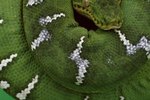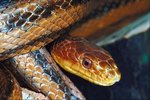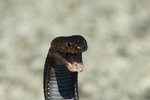
The California king snake (Lampropeltis getula californiae) is a popular pet snake that is native to the United States, ranging from California to Arizona. With proper housing and care, a pet king snake can live up between 10 to 15 years.
Enclosure Size
When housing a hatchling or young king snake, you should use a plastic terrarium with a locking lid—the kind commonly used for transporting reptiles or small animals. As the snake grows, you should upgrade the enclosure size; many sizes of plastic travel cages are available, ranging up to 15 3/4 inches long by 9 3/8 inches deep. Adult king snakes need to be housed in a 20-gallon tank, measuring 30 1/4 inches long by 12 1/3 inches deep.
Temperature
When setting up the enclosure, you want to make sure that you can provide proper heat and humidity. The warm end of the enclosure should be between 90 and 95 degrees Fahrenheit, and the cool side between 78 and 83 degrees. Use an under-tank heater on one side of the tank; make sure it covers only a third of the bottom of the tank. Use a digital thermometer with a probe to measure the surface temperatures of the enclosure.
Humidity
You want to keep the humidity level low. Provide a small water dish that allows the snake to soak, but make sure that the humidity level is at below 40 percent. If you notice that your snake is having shedding issues such as retained skin, you can add a humid hide with moist spaghnum moss or peat moss. Monitor the humidity level with a humidity gauge.
Substrate
Use a substrate that won't increase the humidity in the enclosure. Use aspen wood shavings and CareFresh bedding for juvenile and adult king snakes, but paper towels are a better option for housing a baby snake so that you can monitor healthy bowel movements. Avoid using cedar and pine shavings, as both contain oils that are toxic to your snake.
Decorations and Caves
You want to add at least two caves to the enclosure—one on the warm side and one on the cool side of the enclosure. Many types of commercial hides are available for your king snake, such as half logs, bark rounds and various acrylic and stone caves.
References
Photo Credits
-
Jupiterimages/Photos.com/Getty Images




